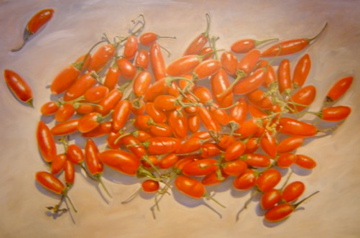 The famous and notorious African birdseye chile is both wild and domesticated and is also known in English as African devil chile, in Swahili as pili-pili and in Kamba (a Bantu language) as ndul. It should be pointed out that pili-pili simply means “pepper-pepper” and is a generic term for any African chile that has two other spellings, piri-piri and peri-peri. Most sources state that the birdseye is Capsicum frutescens, making it a relative of the tabasco chile. It has grown wild in Africa for centuries but has been under commercial cultivation in for many years in Uganda, Malawi, and Zimbabwe. Growing African birdseye chiles is very labor-intensive and they require hand-picking. Pungency can vary according to precise variety of birdseye, where it is grown, and environmental conditions. The birdseye, particularly the Ugandan variety, is thought to be the most pungent chile that is not of the chinense species (hence its notoriety), measuring up to 175,000 Scoville Heat Units. In a test of a variety provided by German chile gardener Harald Zoschke, the ‘Malawi Birdseye’ variety from Africa was measured at 112,226 SHU, and the same variety grown in Harald’s garden was measured at 99,579 SHU.
The famous and notorious African birdseye chile is both wild and domesticated and is also known in English as African devil chile, in Swahili as pili-pili and in Kamba (a Bantu language) as ndul. It should be pointed out that pili-pili simply means “pepper-pepper” and is a generic term for any African chile that has two other spellings, piri-piri and peri-peri. Most sources state that the birdseye is Capsicum frutescens, making it a relative of the tabasco chile. It has grown wild in Africa for centuries but has been under commercial cultivation in for many years in Uganda, Malawi, and Zimbabwe. Growing African birdseye chiles is very labor-intensive and they require hand-picking. Pungency can vary according to precise variety of birdseye, where it is grown, and environmental conditions. The birdseye, particularly the Ugandan variety, is thought to be the most pungent chile that is not of the chinense species (hence its notoriety), measuring up to 175,000 Scoville Heat Units. In a test of a variety provided by German chile gardener Harald Zoschke, the ‘Malawi Birdseye’ variety from Africa was measured at 112,226 SHU, and the same variety grown in Harald’s garden was measured at 99,579 SHU.
Reputedly, the hottest African chiles are those called “Mombassa” and “Uganda,” which are Capsicum chinense, probably introduced by the Portuguese from Brazil. In some parts of Africa, these Habanero-type chiles are called “crazy-mad“ peppers, and “in Manyuema and Urua [in the Congo] there grows a pepper so excessively hot that Arabs who would eat bird’s-eye chilies by handfuls were unable to touch it,” writes Verney Lovett in his book, Across Africa (1877). “It is a small, round, red fruit about the size of a marble.” One of the most notorious, the ominously-named ‘Fatalii’ of the Central African Republic is a superhot chinense that analytical chemist Marlin Bensinger has measured in his laboratory at 350,000 Scoville Heat Units.
Pili-Pili and its variants Piri-Piri and Peri-Peri have become the de facto common terms for the chile pepper in Africa. There are hundreds of other names for the chile peppers of Africa because of the sheer number of languages spoken on the continent. The Portuguese there call the chile pimento, the English refer to it as chilli and capsicum, the Arabic words for it are shatta and felfel, and the French word for chile is piment. Tribal names vary greatly: chile is mano in Liberia, barkono in northern Nigeria, ata in southern Nigeria, sakaipilo in Madagascar, pujei in Sierra Leone, and foronto in Senegal.





